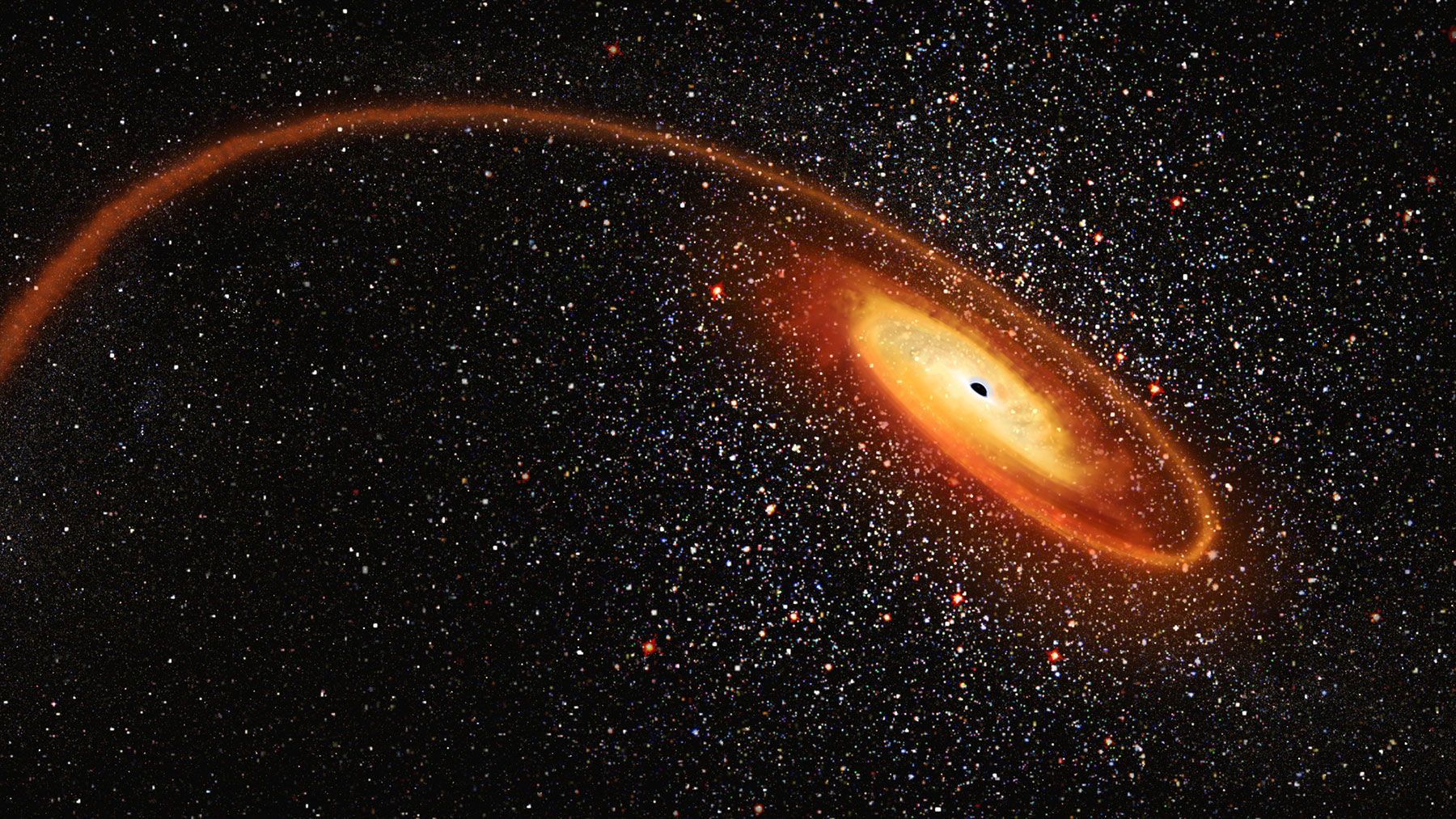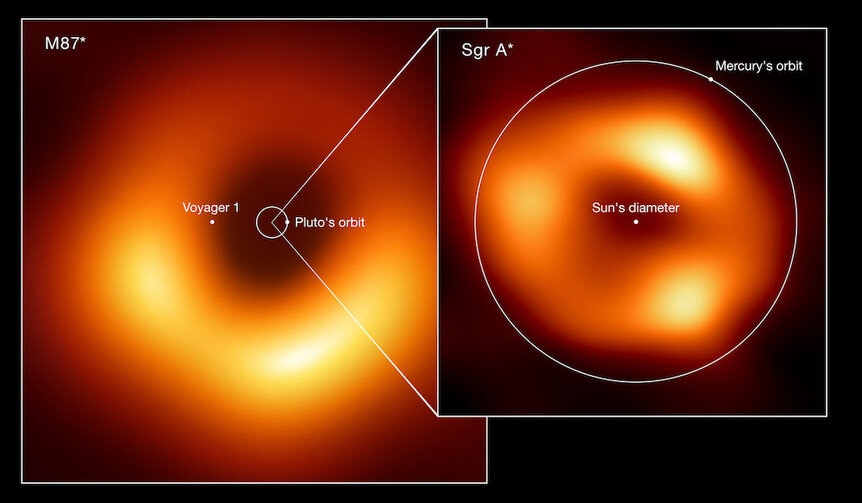Create a free profile to get unlimited access to exclusive videos, sweepstakes, and more!
Small black holes near big black holes may tear apart and eat stars
Small black holes hook up with stars near big black holes. It doesn’t end well for the stars.

You’d think black holes would already be weird enough for some astronomers.
They form in the cores of exploding stars. They defy Newtonian logic, and need Relativity to properly account for their gravity. They warp space and time. They power the most luminous single objects in the Universe. They don’t just pull you down, they spaghettify you first.
So yeah, weird. But not weird enough for some astronomers. They had to look and see if small black holes could be in the accretion disks of huge black holes and also draw in stars close enough to become binary systems and then rip the star to shreds and create a blast so powerful we can see it for billions of light years [link to paper].
Oh. Well. Now that I’ve written that out it’s easy to see why they’d want to know if those exist. Because WOW.
OK, first things first.
We know that in the center of pretty much every big galaxy is a supermassive back hole, a monster with millions to billons of times the mass of the Sun. Some are quiescent, like Sgr A*, the 4-million-solar-mass black hole in the center of our Milky Way. Others are actively drawing in gas and dust, which falls into a disk called an accretion disk. That material gets heated up viciously via friction until material can reach temperatures of millions of degrees, glowing fiercely and observable across the visible Universe. We call this an active galactic nucleus, or AGN for short. M87 is a famous example of one.
That disk is an inferno, and the last place in the Universe you want to be — except maybe closer to the supermassive black hole itself. But, incredibly, it gets worse.
Galaxies have billions of stars and some will be on orbits that are pretty close to the galactic center. In our own galaxy is a cluster of stars called the S Cluster with hundreds of stars, maybe more, that orbit within a light year of Sgr A*. This is likely true of other galaxies as well. Sgr A* doesn’t have a huge accretion disk, but in galaxies with supermassive black holes that do, those stars might plunge right through the disk.
The physics is complicated, but as a star punches through the disk it will draw in some of that disk material and accrete it. Over time that affects its orbit such that eventually it will orbit in the same plane as the disk, literally now spending all its time in the disk. It will continue to accrete matter, and as it does it will lose orbital energy and fall toward the central huge black hole.
The same is true for smaller black holes, the ones that form when a massive star explodes. The core collapses and, if the core is massive enough, will form what we call a stellar-mass black hole. There can be lots of these near the galactic center, and for the same reason can eventually fall into the disk, align their orbits, then spiral their way into the center.
So, what happens if one of these trapped stars meets up with one of these trapped black holes?
Bad things. Very bad things, for the star at least. If a black hole and a star get close enough together they can go into a binary orbit around one another. Again, the disk surrounding them steals orbital energy, and they spiral together. When they get close enough the gravity from the black hole rips the star apart.
This is called, in typical astronomy-speak understatement, a tidal disruption event or TDE. We have seen these in many distant galaxies, usually with a supermassive or intermediate-mass black hole. Since these are smaller events from black holes with roughly a millionth that mass, they’re called micro-TDEs.
The astronomers used simulations to see if this was possible. They created models of a population of stars and black holes around a supermassive black hole with one million solar masses and a big accretion disk. Using typical values for star masses, lifetimes, accretion disk size and density, and an AGN lifetime of about 10 million years, they found that on average you’d expect 100 stars and a handful of black holes to be in the disk.
Then, looking at how long this all takes, how many AGNs there are in the Universe, and so on, they determined how many micro-TDEs we’d expect to see. The answer is 170 per cubic gigaparsec per year. That’s a cube 3.26 billion light-years on a side, so huge, and would contain a lot of galaxies. But that means we’d expect to see a lot of these events.
At the moment we don’t. There could be many reasons for that, including the fact that an AGN is pretty bright and constantly fluctuates in brightness, making it hard to see a micro-TDE. They do note that two events have been seen that are consistent with them being micro-TDEs: ASASSN-15lh, which was about 3 billion light-years from us, and ZTF19aailpwl, which was 4 billion light-years away. Both were exceptionally bright events, brighter than they’d expect from a micro-TDE — both peaked at being about a trillion times more luminous than the Sun, if you needed something to keep you awake at night — but were otherwise consistent with micro-TDEs. They also posit that we saw them because they were so bright, and fainter micro-TDEs are harder to spot.
They also urge astronomers to monitor AGNs with black holes above about 100 million solar masses. Such black holes are so big they eat stars whole, and don’t rip them apart, so you don’t get a TDE at all. If we do see one from such a galaxy, it’s a good micro-TDE candidate. Clever. Also, micro-TDEs look different from regular-sized TDEs; they take longer to reach their peak brightness and tend to emit more high-energy X- and gamma rays, making it possible to distinguish the two.
This is all pretty wild. I love it when astronomers fiddle with ideas like this, starting with things we know can happen and then letting them play out using real physics to see what can happen. Right now only a few TDEs have been seen, but as more big survey telescopes like the Vera Rubin Observatory and the Nancy Grace Roman Space Telescope come online, we’ll be seeing lots more.
Will we spot a micro-TDE? Time, and the voracious maws of black holes, will tell.




























